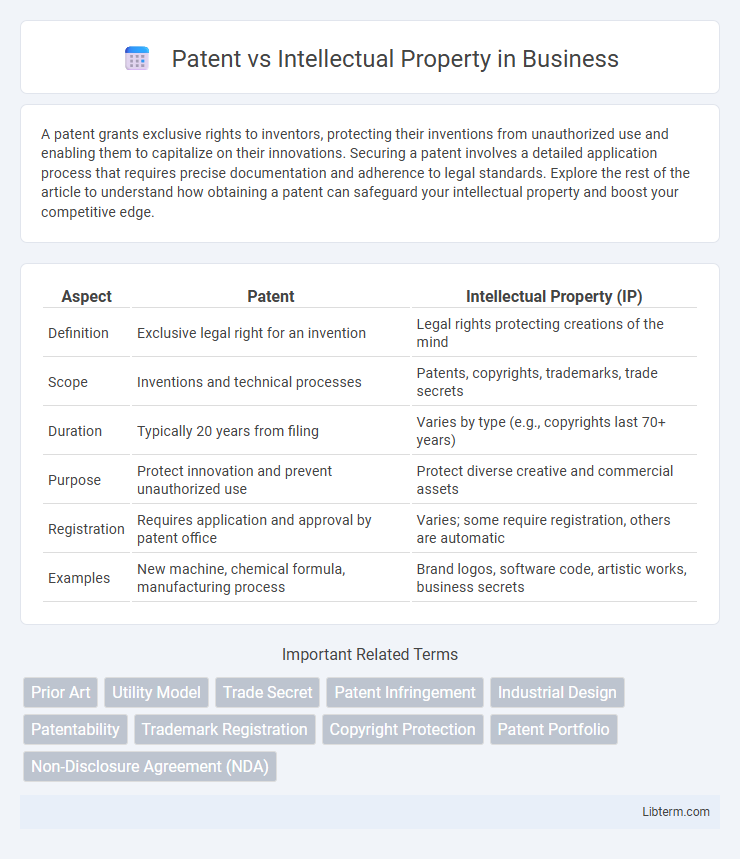A patent grants exclusive rights to inventors, protecting their inventions from unauthorized use and enabling them to capitalize on their innovations. Securing a patent involves a detailed application process that requires precise documentation and adherence to legal standards. Explore the rest of the article to understand how obtaining a patent can safeguard your intellectual property and boost your competitive edge.
Table of Comparison
| Aspect | Patent | Intellectual Property (IP) |
|---|---|---|
| Definition | Exclusive legal right for an invention | Legal rights protecting creations of the mind |
| Scope | Inventions and technical processes | Patents, copyrights, trademarks, trade secrets |
| Duration | Typically 20 years from filing | Varies by type (e.g., copyrights last 70+ years) |
| Purpose | Protect innovation and prevent unauthorized use | Protect diverse creative and commercial assets |
| Registration | Requires application and approval by patent office | Varies; some require registration, others are automatic |
| Examples | New machine, chemical formula, manufacturing process | Brand logos, software code, artistic works, business secrets |
Understanding Patent and Intellectual Property: Key Definitions
Patents are legal rights granted for inventions, providing exclusive protection to inventors for a limited period, typically 20 years. Intellectual Property (IP) encompasses a broader range of creations, including patents, trademarks, copyrights, and trade secrets, safeguarding various forms of intangible assets. Understanding patents as a subset of IP clarifies the specific protection mechanisms for technological innovations within the larger framework of intellectual property law.
Types of Intellectual Property: Where Patents Fit In
Intellectual property (IP) encompasses various types including patents, trademarks, copyrights, and trade secrets, each protecting different forms of creativity and innovation. Patents specifically safeguard inventions and technical processes by granting exclusive rights to creators for a fixed period, typically 20 years from the filing date. This specialized protection encourages innovation by preventing others from making, using, or selling the patented invention without permission.
Patents Explained: Purpose and Protection
Patents provide exclusive legal rights to inventors for their novel inventions, preventing others from making, using, or selling the invention without permission. They serve to protect technological advancements by granting a time-limited monopoly, typically lasting 20 years from the filing date. This protection encourages innovation and investment by ensuring inventors can commercially benefit from their creations.
Scope of Intellectual Property Beyond Patents
Intellectual property (IP) encompasses a broad range of legal rights protecting creations of the mind, including patents, trademarks, copyrights, and trade secrets. Patents specifically grant exclusive rights for inventions, covering new processes, machines, or compositions of matter for a limited duration, typically 20 years. Beyond patents, IP covers brand identity through trademarks, creative works via copyrights, and confidential business information under trade secrets, providing comprehensive protection across multiple domains of innovation and creativity.
Patent Application Process vs. Other IP Rights
The patent application process involves a detailed examination to ensure novelty, inventive step, and industrial applicability, often taking several years and requiring formal documentation and claims drafting. Other intellectual property rights, such as trademarks or copyrights, generally have faster registration processes and focus on brand identity or original works of authorship without the stringent novelty criteria. While patents protect inventions and technical innovations, trademarks safeguard brand names and logos, and copyrights cover literary and artistic works, each category requires tailored application procedures reflecting their distinct legal criteria.
Duration and Enforcement: Patents vs. Other IP Types
Patents typically grant exclusive rights for 20 years from the filing date, providing strong legal protection against unauthorized use or production. Other intellectual property types, such as copyrights, can last much longer--often the life of the author plus 70 years--while trademarks can be renewed indefinitely as long as they are in use. Enforcement of patents involves rigorous examination and litigation processes, whereas other IP enforcement depends on different legal frameworks, with trademarks and copyrights often managed through usage and registration renewals.
Costs Involved: Patent Protection vs. Other IP Protections
Patent protection typically involves higher costs compared to other intellectual property rights due to extensive application fees, attorney charges, and maintenance expenses. Trademark and copyright registrations usually incur lower upfront costs and less complex maintenance fees. Businesses should weigh these financial commitments against the strategic value of exclusive rights granted by patents versus broader protections offered by other IP categories.
Advantages and Limitations: Patent vs. Intellectual Property
Patents provide exclusive rights to inventions, preventing others from making, using, or selling the patented technology for a specific period, typically 20 years, enhancing competitive advantage and potential revenue streams. Intellectual property (IP) encompasses a broader range of protections, including copyrights, trademarks, trade secrets, and patents, offering diverse ways to safeguard creative works, brand identity, and innovation beyond just inventions. Limitations of patents include high costs, strict eligibility criteria, and limited duration, whereas overall IP protections vary in scope, cost, and enforceability, requiring strategic management to maximize business value.
Choosing the Right IP Strategy for Your Innovation
Selecting the appropriate intellectual property (IP) strategy hinges on the nature of your innovation and its market potential, with patents offering protection for novel inventions through exclusive rights, typically lasting 20 years. Trademarks, copyrights, and trade secrets serve different purposes, safeguarding brand identity, creative works, and confidential information respectively. Strategic alignment of these IP tools maximizes commercial value, deters infringement, and supports long-term competitive advantage in industries ranging from technology to pharmaceuticals.
Frequently Asked Questions: Patent vs. Intellectual Property
Patents are a specific type of intellectual property that protect inventions and grant exclusive rights to inventors for a limited period, typically 20 years. Intellectual property encompasses patents, trademarks, copyrights, and trade secrets, covering a broader range of creations and brand identifiers. Common questions often address the difference in scope, duration, and protection mechanisms between patents and other forms of intellectual property.
Patent Infographic

 libterm.com
libterm.com